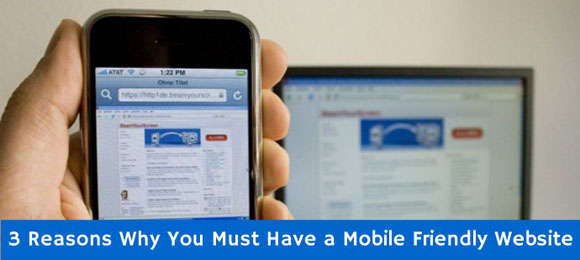
Original post from Grove Digital Marketing.
“Do I need a mobile friendly website?”
Have you asked yourself this question recently? Smart phones and other mobile devices are fast becoming the preferred method of Internet access; if you haven’t already got a mobile website, you need to get one soon.
Why? Because your customers are increasingly going mobile.
Mobile Online Shopping Time Now Exceeds Laptop/PC Online Shopping Time
Over the past few years, including a huge burst in 2013, there was a seismic shift in shopping trends. As far back as June 2013, the online shopping champions had become – you guessed it – mobile devices. They officially passed desktop PCs and laptops, garnering 55% of consumer shopping time spent online as measured, as compared to 45% for laptops and desktops combined.
According to IAB.net, nearly half of the U.S. population has a mobile phone with Internet access, and one in five page views on the Web happen on a mobile device.
In Sizmek’s annual Global Benchmark Report, “Breaking Boundaries: Engagement Gone Global,” the shift towards more mobile friendly formats using HTML5 is emphasized as one of the most important changes in digital advertising during 2013.
The report, which revealed major trends in digital advertising from more than 913 billion ad impressions worldwide for 2013, says to “expect engagement rates for HTML5 to increase in 2014 as the industry adopts rigorous creative and publishing standards that ensure seamless multiscreen delivery.”
Mobile is Not Just a Must for eCommerce Sites
People are increasingly doing all sorts of online research using mobile devices.
A Google survey found that:
- 74% of visitors were more likely to return to mobile friendly websites
- 61% were likely to leave if a site wasn’t mobile friendly, and
- 67% were more likely to buy at a mobile friendly website
If your site isn’t mobile-friendly, you’re losing business.
1. It’s What Your Customers Want – and They Expect You to Provide It
Increasingly, your customers are not sitting front of desktops or laptops. Instead, they’re on the go, and they’re accessing your website from their mobile devices.
What does that mean for you? If you don’t give customers what they want (easy visibility and navigation so they can browse and shop while mobile), they’ll go someplace else.
So how do you go about creating a mobile-friendly site? Don’t try to simply “tweak” your existing website to try to make it so. Traditional websites don’t display well on mobile phones.
Mobile phones have smaller displays and will often distort visuals on regular websites. Pare your mobile friendly website down to just essential features, with content that includes links to secondary information pages. You should also enlarge interface elements for easy touchscreen navigation.
That doesn’t mean you should ignore those customers who still use desktops and laptops, though. They still account for a significant portion of your customer base and new prospects.
Change Your Standard Website to a Responsive Website

Instead, opt for a responsive website. A responsive website recognizes the device being used (laptop, PC, tablet, smartphone, etc.) and will resize itself accordingly for optimal viewing. You’ll be able to accommodate mobile and PC/laptop users alike.
Don’t ignore your customers, because your competition will be only too happy to serve them. “Do I need a mobile friendly website?” Yes, because customers are searching and shopping on mobile devices in increasing numbers.
2. Google May Penalize You if You Don’t Have a Mobile Friendly Website
It’s true, and there’s a reason for that. Google recognizes that you don’t need a computer to surf the Internet. Many sites, however, still use content, images, and navigation structures that just don’t work well on mobile devices.
Users can only see those websites properly using a desktop or laptop monitor or screen, and smart phone browsers end up with a very unsatisfying user experience.
Why does that matter to Google? Because if a particular website isn’t mobile friendly, Google will recognize that and be less likely to display it as a legitimate search result.
That makes sense, since Google wouldn’t be doing its job if half the results displayed were useless to mobile users. Google’s goal is to increase search traffic, including mobile search traffic, and you can use that to your benefit by jumping on board.
So when you’re asked, “Do I need a mobile friendly website?” answer “yes.” It will help your organic search results.
3. You’ll Lose Business (If You Haven’t Already)
You’ve probably already seen a decline in business if you still use only a standard website. If not, go mobile friendly before you do. Most aren’t yet completely ditching their desktops or laptops for their mobile devices, but an increasing number are.
Give your customers what they want with fast loading pages, easy navigation, and a streamlined site with great content and great products. Grab hold of that growing number of customers who use mobile devices to shop. Keep Google happy, too, and you won’t risk “disappearing” from search results.
Other Website Must-Haves
Is your website mobile-friendly? If not, what questions do you have about converting it to one that is?
Beyond just being mobile-friendly, do you know if your website is optimized to get YOU traffic and leads? Find out. Download our free report: 25 Website Must Haves for Driving Traffic, Leads and Sales, and get more traffic to your website today!
Hey, thanks for the info. Now what?
Have questions or comments? Please use the comment form down below. We read and reply to every comment.
If you really enjoyed this post, please help us to spread the word by clicking one of the social media sharing buttons.